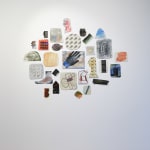





Richard Killeen
How may we learn?, 1992
acrylic and collage on aluminium
29 pieces, 1400 x 1800mm pictured, dimensions variable
Further images
Developed over his decades-long career, there is no single, authorised ‘reading’ of Killeen’s cut-outs. Made from cut aluminium, then hand painted with alkyd paint on paper, this is the style...
Developed over his decades-long career, there is no single, authorised ‘reading’ of Killeen’s cut-outs. Made from cut aluminium, then hand painted with alkyd paint on paper, this is the style he is most well-known for. Looking like encyclopaedic plates or taxonomic museum displays, the works combine images drawn from a wide range of sources - insects, plants, machines, tools, figures, geometric shapes and abstract symbols.
In abandoning the frame, Killeen defies traditional compositional structures, breaking down distinctions between painting, drawing, sculpture and installation. Killeen prescribed simple display instructions for many of his works - ‘hang in any order’. Each individual work within these cut-outs is endlessly moveable, with each configuration opening new conversations and relationships between the individual images. This non-hierarchical construction of the works implies that each image is created equal, denying any authoritative meaning emanating from the artist.
Although Killeen may relinquish control of the final composition, he still determines the number of included images, their scale, colour and content. He allows an element of chance whilst also ensuring inevitability in the overall style and feel of the works. What unifies the cut-outs is their playful sense of humour, with the viewer able to make their own associations from the jumbled images – a reflection of the consensus of the human experience. Killeen’s art practice explores how our reading of images and objects both reflect and create our culture, asking How May We Learn?
In abandoning the frame, Killeen defies traditional compositional structures, breaking down distinctions between painting, drawing, sculpture and installation. Killeen prescribed simple display instructions for many of his works - ‘hang in any order’. Each individual work within these cut-outs is endlessly moveable, with each configuration opening new conversations and relationships between the individual images. This non-hierarchical construction of the works implies that each image is created equal, denying any authoritative meaning emanating from the artist.
Although Killeen may relinquish control of the final composition, he still determines the number of included images, their scale, colour and content. He allows an element of chance whilst also ensuring inevitability in the overall style and feel of the works. What unifies the cut-outs is their playful sense of humour, with the viewer able to make their own associations from the jumbled images – a reflection of the consensus of the human experience. Killeen’s art practice explores how our reading of images and objects both reflect and create our culture, asking How May We Learn?
Provenance
Private Collection, NZExhibitions
Richard Killeen, How may we learn, 1992, Ray Hughes Gallery, SydneyGroup Exhibition, Spring Catalogue 2024, 25 September - 19 October 2024, Gow Langsford Gallery, Auckland, New Zealand
Richard Killeen, Hang In Any Order, 3 - 27 July 2024, Gow Langsford Gallery, Auckland, New Zealand
12
of
12





